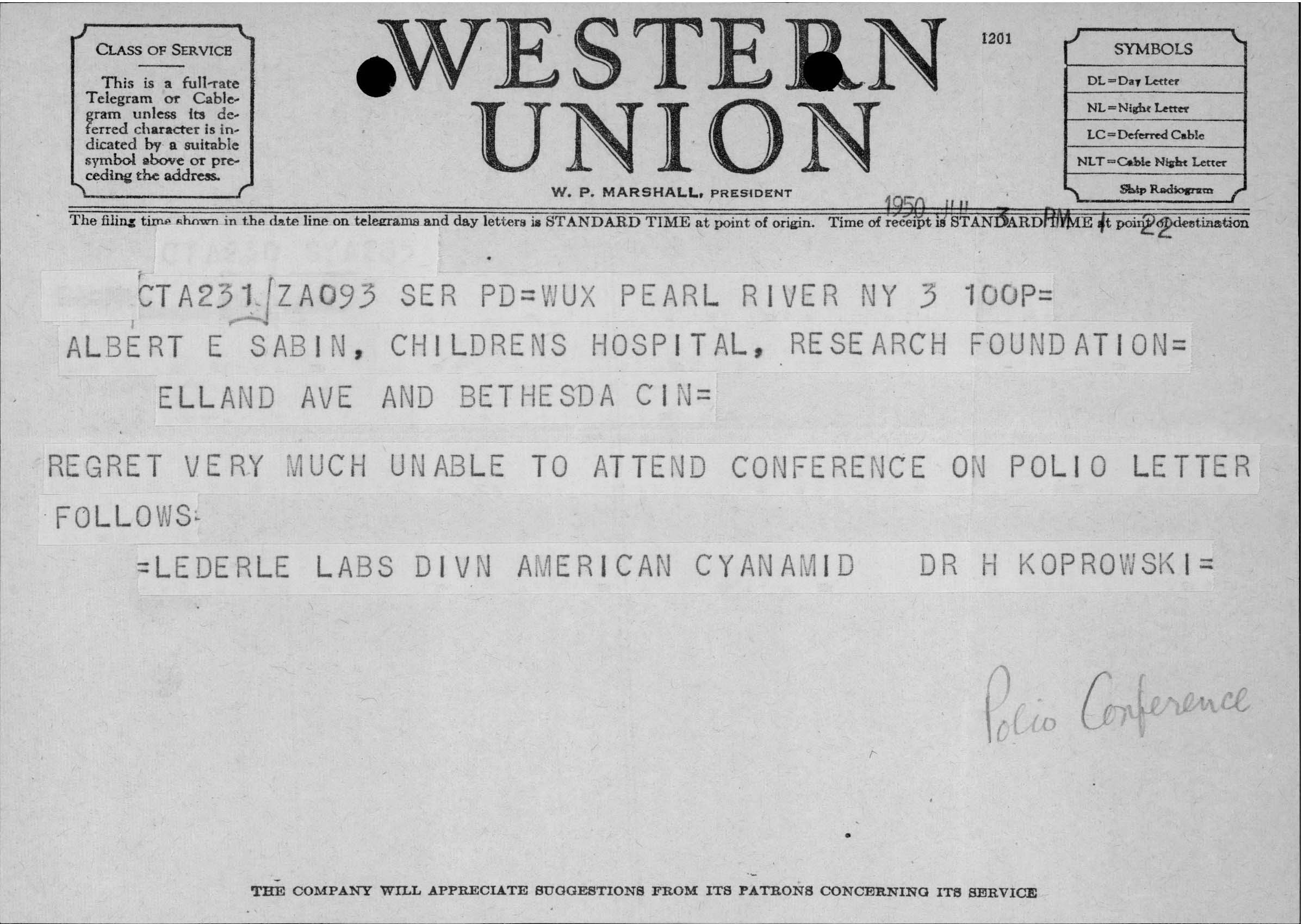By Jeff O’Flynn, Sabin Student Assistant

Telegram from Hilary Koprowski to Albert Sabin, indicating he would be unable to attend a polio conference.
Hilary Koprowski is considered by many to be equally important as Salk and Sabin in the quest to eradicate poliomyelitis. When Koprowski passed away last month, his illustrious career was recounted in his obituary and included such notable achievements as the development of a live-virus polio vaccine, improvement of the rabies vaccine, and directorship of the world-renowned Wistar Institute in Pennsylvania. His interest in the live-virus polio vaccine caused his career to overlap with Albert Sabin’s work regularly. The obituary details the competition between Sabin and Koprowski for the eventual triumph of their various polio vaccines.[1] Letters in the Albert B. Sabin archives indicate that the two great scientists often shared material and data though, unfortunately, they did not have an entirely conflict-free relationship.
Much of their correspondence is simply “thank you” letters for strains of virus or data exchanged. Their early exchanges were cordial including an invitation for Sabin to stay with Koprowski when visiting New York. Koprowski offers to arrange an evening of musical performances[2] which would surely have been entertaining since he was a concert pianist and composer and Sabin was a lover of classical music.
As the polio wars—the race to create and license an effective vaccine to eliminate the threat of polio—heated up through the 1960s, their communications became more competitive. In late 1958, the two exchanged letters in which they disagreed on some experimental results. Sabin informed Koprowski that he could not duplicate Koprowski’s findings but softened the blow by stating that “it would not be the first time a busy, senior investigator had been misled by data reported to him by less experienced assistants.”[3] In his reply, Koprowski highlights several points of disagreement with Sabin’s work. Like Sabin, he removes some of his criticisms’ sting by including this La Rochefoucauld quote: “Les querelles ne dureraient pas longtemps, si Ie tort n’était que d’un coté.”[4] (Quarrels wouldn’t last so long if only one side was at fault.)
Koprowski was a staunch defender of his own work. In a letter to United States Surgeon General Leroy Burney, he addresses critiques directly and outlines why he believes his work merits consideration.[5] Even with his efforts, Sabin’s vaccine eclipsed his colleague’s and garnered world-wide attention and support. A tireless worker, Koprowski continued his scientific work in vaccines and cancer and eventually went on to win the Albert B. Sabin Gold Medal award in 2007. In his acceptance speech, he recounted several meetings he had with Sabin. He also spoke about the polio wars: “The principal protagonists were Albert Sabin and Jonas Salk. My participation was minimal except that I always supported the concept of live oral virus vaccine vs. formalin-inactivated virus vaccine.”[6]
At the end of his speech, Koprowski mentions several other positive encounters they had after the polio wars including an instance where Sabin defended him against criticism of his live virus polio vaccine trials in the Congo. Finally, he recounted an obituary he wrote for Sabin: “At one time, Sabin and I became adversaries over the selection of polio virus strains to be used as oral vaccines. This did not affect our long-lasting friendship and mutual respect. Courageous and wise. This is how I see him; I will miss him sorely.”[7]
The Sabin digital collection contains many of the letters exchanged between Drs. Sabin and Koprowski. To browse them, please visit the collection’s website.
References
[1] “Hilary Koprowski, Who Developed First Live-Virus Polio Vaccine, Dies at 96,” New York Times, April 20, 2013.
[2] Letter from Koprowski, Hilary to Sabin, Albert B. dated 1953-01-06.
[3] Letter from Sabin, Albert B. to Koprowski, Hilary dated 1958-11-17.
[4] Letter from Koprowski, Hilary to Sabin, Albert B. dated 1958-12-01.
[5] Letter from Koprowski, Hilary dated 1960-08-26.
[6] Hilary Koprowski’s Albert B. Sabin Gold Medal Speech (May 1, 2007).
[7] Ibid.
In 2010, the University of Cincinnati Libraries received a $314,258 grant from the National Endowment for the Humanities (NEH) to digitize the correspondence and photographs of Dr. Albert B. Sabin. This digitization project has been designated a NEH “We the People” project, an initiative to encourage and strengthen the teaching, study, and understanding of American history and culture through the support of projects that explore significant events and themes in our nation’s history and culture and that advance knowledge of the principles that define America. Any views, findings, conclusions, or recommendations expressed in this blog do not necessarily reflect those of the National Endowment for the Humanities.
